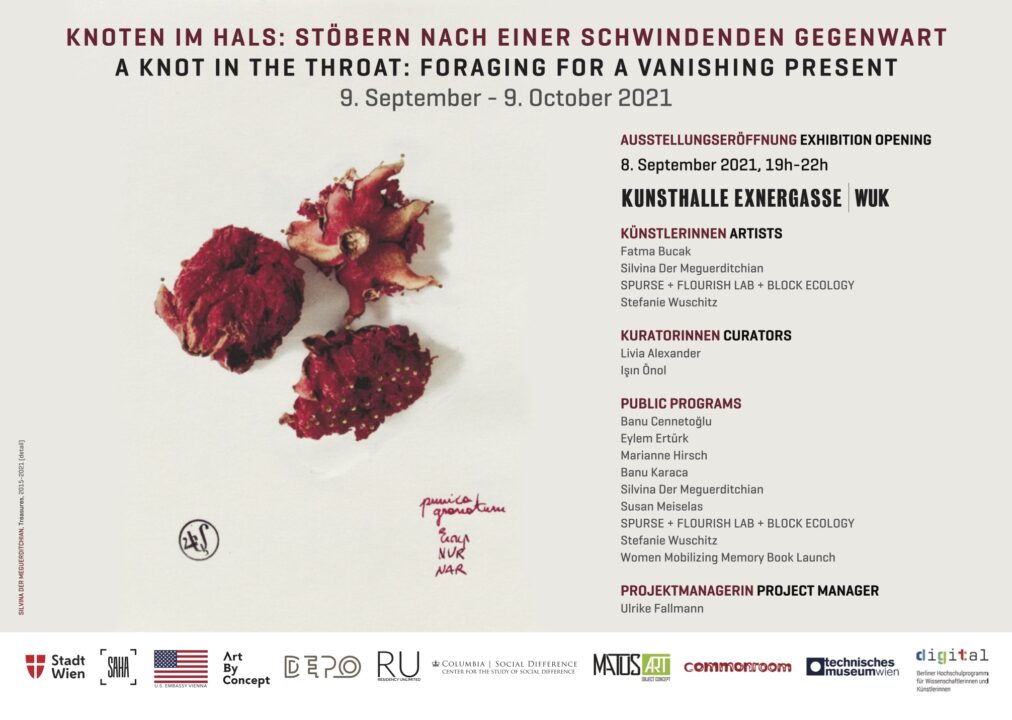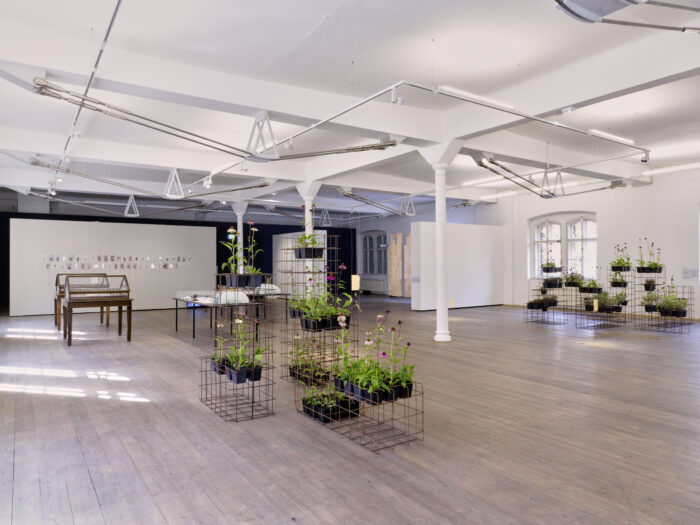A KNOT IN THE THROAT: FORAGING FOR A VANISHING PRESENT

8.9. – 9.10. 2021
KUNSTHALLE EXNERGASSE, VIENNA
EXHIBITION OPENING
8. September 2021, 19h-22h
Artists:
Fatma Bucak | Silvina Der Meguerditchian | SPURSE + FLOURISH LAB + BLOCK ECOLOGY | Stefanie Wuschitz
Public Programs:
Banu Cennetoğlu | Silvina Der Meguerditchian | Eylem Ertürk |
Marianne Hirsch | Banu Karaca | Susan Meiselas | SPURSE + FLOURISH LAB + BLOCK ECOLOGY | Stefanie Wuschitz | Women Mobilizing Memory Book Launch
Curators:
Işın Önol & Livia Alexander
Project Manager:
Ulrike Fallmann
Exhibition Assistance:
Rebecca Schmidt
Graphics Design:
Fürüzan Melis Bağatır

Exhibition view © Lichtbildkultur Martin Schlager
A Knot in the Throat: Foraging for a Vanishing Present
is it a betrayal
when the tree holds on to
a handleless axe? [1]
Everything flows – mostly through tubes. In an unremitting stream, water, body fluids, gases, life circumstances, are channeled through pipes, ducts, and conduits. In a paradox to the abundant praise of free flows in world economies, human systems often create one direction of material motion: the control of goods, the direction of travel, or the flow of capital. Controlling flow is an essential element for the production of power. Any deviation from the standard path is constrained, hence the tubes.
Experts in tubular strategy have long highlighted that rather than being overly soothed by the vision of fast-forward, fluid and frictionless travel through networks of tubes, one should always remain conscious of the possibility of a bottleneck. These bottlenecks, imaginary and concrete at one and the same time, are also where the new ecosystem of possibilities arise, where a fragile imagination of another future presents itself and new communities form.
In our human tubularity, the main bottleneck is clearly the neck, more specifically: the throat. A perpetual traffic flow of gasses, drink, fodder, and words must pass through this chokepoint. The throat is under constant duress as the access point to our vital affairs, and together with the carotid arteries and the spinal cord, forms the high-bandwidth narrows that joins mind and body together. No wonder that breathing, eating, and speaking take on new meanings and perils at every turn of environmental tragedy and political blathering.
In this light it makes sense that the evolution of the homunculi that our minds use to map emotions onto our bodies has zeroed in on the throat as the stage for the internal perception of a cognitive blockage. If we have a knot in the throat, then we hallucinate an entangled clot as an obstacle; a hurdle to performing under the judging gazes of others, to raising our voice in the face of adversity, to letting a flow of tears resolve a sadness that’s stuck in us. It is interesting to ask whether this internal perception of the knot in the throat is a pure hallucination, a phantom gesture to self, or whether our brain goes as far as causing a muscular contraction around our breathing tube to generate the sensory feedback that is seemingly necessary to convince itself that what lies ahead is socially terrifying.
It is with a knot in the throat that we conceive of this exhibition. Haven’t the reasons to mourn multiplied exponentially? Hasn’t the possibility of speaking up and living a dissenting life become more inhibited? Isn’t the flow of air and water, of thought and people all blocked up? Hasn’t “freedom” become a mere permission to pass through certain tubes? We have to swallow sometimes in order not to cry.
At this moment, we may take comfort with the knowledge that the knot in the throat also marks a transition phase, a pivotal moment, a hesitation before a new motion can become unstuck. A bottleneck may act as a compressor of trajectories, in which neighboring itineraries interfere, so that a minor deviation from an original path, an unexpected bump into each other, may lead to the articulation of refined and distinct flows – or even entirely new states of matter – after the bottleneck. A knot in many throats may come undone and erupt in a string of words that carries tension, urgency, and novelty. What does it take?
The present exhibition at Kunsthalle Exnergasse assembles a group of works that search for ways to address the knot in the throat, to externalize this most intimate manifestation of an inhibiting state of mind, to forage for potential remedies. It may be the very act of foraging that can catalyze a process of relief: An unconstrained search for nutrients, guided by the phantasmagoric warmth that the observant seeker may sense at locations where previously, an intact ecosystem had luxuriated a gift.
Foraging, as a practice of multi-directional harnessing of available resources, may suggest a pursuit of that which is not in plain sight, conferring comfort in the promise of possibilities prompted by a present that embodies lingering traces of the yet-to-be-told. Drawing on silenced histories, on knowledge passed down and new, on transformed urban ecosystems, in A Knot in the Throat: Foraging for a Vanishing Present we attempt to retrain our sight on a fluidity of another kind. The flow of a present, vanishing at the very moment it is formed, before it can be molded into a history, before it can shape the future with all its fragility.
Işın Önol & Livia Alexander
With sincere thanks to Tobias Nöbauer for his insightful contribution
[1] Barış Acar, Dust, Haiku, Veyayinevi, 2016